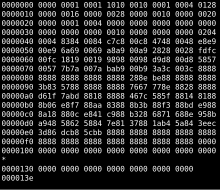Binary file
To send binary files through certain systems (such as email) that do not allow all data values, they are often translated into a plain text representation (using, for example, Base64).Other type of viewers (called 'word extractors') simply replace the unprintable characters with spaces revealing only the human-readable text.For example, the user would see any URL/email to which the suspected software may attempt to connect in order to upload unapproved data (to steal).For example, a binary file interpreted by the ASCII character set will result in text being displayed.A custom application can interpret the file differently: a byte may be a sound, or a pixel, or even an entire word.Binary itself is meaningless, until such time as an executed algorithm defines what should be done with each bit, byte, word or block.This fact can be used in steganography, where an algorithm interprets a binary data file differently to reveal hidden content.
Binary starDisk imagehex dumpfaviconcomputer filetext filefile formatscomputer document filesformatted textcharactersCompiledheadersmetadatacomputer programsignature or magic numberBase64asymmetric cryptographywebsite certificatesentropyBinary-to-text encodingMicrosoft Windowscarriage returnUnix-likehex editortext editorexecutablemachine languagesteganographybinary codeexecutable fileBinary compatibleWindowsMacintoshendiannessBinary large objectDisassemblerList of file formatsComputer filesData fileFile formatFile signaturesMagic numberOpen file formatsProprietary file formatsMetafileSidecar fileSparse fileSwap fileSystem fileTemporary fileZero-byte fileFilename8.3 filenameLong filenameFilename manglingFilename extensionList of filename extensionsFile attributeExtended file attributesFile sizeHidden file / Hidden directoryDirectory/folderNTFS linksTemporary folderDirectory structureFile systemFilesystem Hierarchy StandardGrid file systemSemantic file systemOperationsFile descriptorHard linkShortcutShadowSymbolic linkBackupFile comparisonFile copyingData compressionFile managerComparison of file managersFile system fragmentationFile-system permissionsFile transferFile sharingFile synchronizationFile verification

